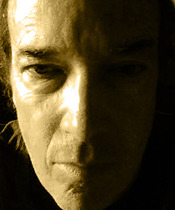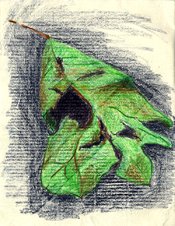Sunset, Friday, 29 January 2010
 William Theodore Van Doren. Sunset from Stony Point, Albemarle County, Va. Oil on watercolor block, 16 x 20.
William Theodore Van Doren. Sunset from Stony Point, Albemarle County, Va. Oil on watercolor block, 16 x 20.
Perhaps a little snow in the offing.
This was one of those days when water freezes in the ground and makes magic little ice caverns, or castles, underfoot – dense combs of gleaming, finely striated vertical ice crystals, just an inch or two tall, pushing up the red mud.
When I was a kid and encountered these on the walk to school, they seemed amazing. There was that sense of having discovered something new – I mean, really new – had anyone ever seen such a thing? After all, no one had ever said to me, “Listen, someday you’re going to run into these magic ice crystals in the mud – don’t get too excited, we already know about them.”
Quite a few things appeared that way – enormous roots bulging out of a creek bank might have been the most spectacular sight of its kind, for all I knew – and had anyone else ever been to this spot in the woods ... in all of human history? My brother Steve and I would find things like that and, like all great explorers, give them names. An abandoned gravel pit far off in the woods – I’m not sure how we managed to consider an abandoned pit something new, exciting and exclusively ours, but that was Frying Pan Canyon. An arena custom-made for throwing rocks.
Even something new only in the sense that it happened to be in a transient state or condition could feel like a discovery. If a bit of swamp froze over enough to allow a rare game of ice hockey – slapping a pine knot around with broken branches – that day of a frozen swamp qualified as something like an unprecedented and perhaps unrepeatable miracle.
Today by the Rivanna, after this week’s floods, Flint and I walked through large areas of woods that had been under water. Along the banks everything was covered in a heavy layer of silt (marbled with what looked like black sand – topsoil?) and small trees nearest the river were plastered all over their skinny branches with papier-mâché handfuls of leaves, twigs and mud. Flint was excited by the fresh stratum of earth; to a scent hound, it seems when there’s any new covering on the ground – snow, or in this case silt – it’s not so much that a place has changed in one aspect, the geography of scent is so different it’s an entirely new place.
Finding all the changes wrought by the flood, and being the first and perhaps only one to see them, at least here, was like the first time seeing ice in the mud. To be discovering things is very fine.
 Friday, January 29, 2010 at 09:16PM | by
Friday, January 29, 2010 at 09:16PM | by  BVD | in
BVD | in  Sunset Paintings | tagged
Sunset Paintings | tagged  Blue Ridge,
Blue Ridge,  Flint the foxhound,
Flint the foxhound,  Rivanna River,
Rivanna River,  Stephen Van Doren,
Stephen Van Doren,  childhood,
childhood,  ice | | Comments Off
ice | | Comments Off 









